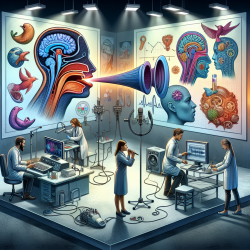Understanding the complex interplay of factors contributing to voice disorders is essential for speech-language pathologists and other professionals involved in voice therapy. The research article, "The Psychopathology of Voice Disorders," by L.A. Rammage, H. Nichol, and M.D. Morrison, offers valuable insights into the psychopathological processes that may underlie symptom formation in voice disorders. This blog post aims to help practitioners improve their skills by implementing the outcomes of the research presented or by encouraging them to do further research.
At the core of voice production lies a sophisticated interaction of organic, psychological, and social factors. The article underscores the importance of recognizing the psychological level's contribution to voice disorders, particularly those of a psychogenic nature. Understanding the various types of pathogenesis involved in producing dysphonias with a psychogenic basis can significantly enhance the treatment and therapy directed at these disorders.
Here are key takeaways from the article and how they can be applied in clinical practice:
- Recognize the Types of Pathogenesis: The article identifies several pathogenetic processes, including tensional symptoms arising from anxiety, symbolic symptoms as a form of unconscious conflict, hypochondriacal symptoms, depressive equivalent symptoms, and the interplay between organic and psychogenic processes. Recognizing these types can guide clinicians in tailoring their therapeutic approaches more effectively.
- Interdisciplinary Approach: The value of an interdisciplinary team comprising otolaryngologists, speech-language pathologists, and psychiatrists cannot be overstated. Such collaboration ensures a comprehensive assessment and a unified treatment plan, enhancing the consistency of information and reinforcement given to the patient.
- Address Muscle Misuse: The article highlights that the muscles of phonation are the final common path of all dysphonias of psychogenic origin. Identifying and reducing muscle misuses is a primary part of the therapy program. Techniques aimed at relaxing and properly using these muscles can be crucial in treating psychogenic voice disorders.
- Consider the Function of Psychogenic Dysphonia: Understanding whether the dysphonia serves a primary or secondary gain for the patient can influence treatment direction. This insight helps in addressing not just the symptom but also the underlying psychological issues contributing to the disorder.
- Evaluate Etiological Factors: A comprehensive evaluation of the factors predisposing, precipitating, or perpetuating voice disorders is essential. Early evaluation and intervention are particularly important for identifying psychological etiological factors and providing effective therapy.
Implementing these insights requires practitioners to adopt a holistic view of voice disorders, considering the interplay between physical, psychological, and social factors. This approach not only aids in more accurately diagnosing and treating voice disorders but also emphasizes the need for a compassionate understanding of the patient's experience.
Continued research and education in the psychopathology of voice disorders are crucial for advancing our understanding and treatment of these complex conditions. Encouraging an interdisciplinary approach and fostering communication among professionals can lead to more effective and comprehensive care for individuals with voice disorders.
For speech-language pathologists and other voice therapy practitioners, integrating the findings from "The Psychopathology of Voice Disorders" into clinical practice can enhance the quality of care provided to patients with voice disorders. It invites a deeper exploration of the psychological aspects of voice production and the importance of addressing these factors in therapy.
To read the original research paper, please follow this link: The Psychopathology of Voice Disorders.










